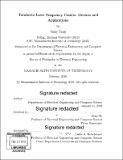Terahertz laser frequency combs : devices and applications
Author(s)
Yang, Yang,Ph. D.Massachusetts Institute of Technology. Department of Electrical Engineering and Computer Science.
Download1102049055-MIT.pdf (24.88Mb)
Other Contributors
Massachusetts Institute of Technology. Department of Electrical Engineering and Computer Science.
Advisor
Qing Hu.
Terms of use
Metadata
Show full item recordAbstract
In recent years, there has been growing interest in chip-scale frequency combs, such as micro-resonator combs and semiconductor mode-locked sources. From the mid-infrared to the terahertz regime, it has been shown that quantum cascade lasers (QCLs) are capable of forming a frequency comb state where dispersed cavity modes of the Fabry-Perot cavity are synchronized by third order nonlinearity. With proper dispersion engineering, we have shown that it is possible to create QCL frequency combs at terahertz wavelengths, which possess broadband coverage in a compact package. These QCL combs are particularly attractive as sources for high-sensitivity laser spectroscopy: by using a dual-comb technique, it is possible to perform broadband spectroscopy only using chip-scale components, making it an intriguing candidate for spectroscopic applications in the open field. Moreover, due to the semi-continuous nature of the temporal output from such combs, tracking the instantaneous phase and timing signals of the dual-comb waveform in the time domain becomes feasible. This enables a computational coherent averaging scheme of the dual-comb signal even without external reference. The first part of this thesis describes the development for better THz laser frequency combs. To realize all expectations in the spectroscopy applications using such devices, three main aspects of improvement are highly desired. First, the laser device should have a robust comb state that ideally can operate from device's threshold current, I[subscript th], to its maximum current, I[subscript m]. In addition, the comb states should have a broad spectral coverage: its bandwidth should cover at least an octave span to stabilize its carrier offset. Furthermore, the comb state should have a flexible tunability that allows tuning across the entire free spectral range for gapless sensing. All listed aspects are investigated during the course of this thesis and as a result, a THz QCL device featuring comb state performance over the entire lasing bias range has been demonstrated. Meanwhile, we show that, by compensating cavity dispersion up to higher orders, the comb bandwidth from the full dispersion compensated devices can reach 80 % of its gain bandwidth. One common method to achieve very broadband coverage relies on using the heterogeneous gain media. This comes at the cost of reduced peak gain and hampered temperature performance. Also, engineering the dispersion of such a broadband gain medium becomes extremely challenging, which might not lead to a broader comb coverage albeit its broader gain. However, a unique feature of the metal-metal waveguide is that it is completely agnostic about its bonded gain media. Therefore, it is possible to bond multiple gain media together onto the same chip. The lateral heterogeneous integration scheme is investigated as an alternative method to expand the comb's spectral coverage. We show that using this strategy we can couple the output of combs at vastly different wavelengths without the trade-off with its temperature performance, yet maintain a compact package. Dual-comb spectroscopy allows for high-resolution spectra to be measured over broad bandwidth, but in order to achieve high resolution and acquire low-uncertainty spectroscopic information, the capability for coherent averaging is of the most importance. An essential requirement for coherent averaging is the availability of a phase reference. Usually, this means that the combs' phase and timing errors must be measured and either minimized by stabilization or removed by correction. These hardware-based solutions often require extra electronic or optical components, thus complicates the overall system and further limits the technique's applicability. We demonstrate that it is possible to extract the phase and timing signals of a multiheterodyne spectrum in a completely computational fashion without any extra measurements, which can potentially simplify any dual-comb system. Other works in this thesis include the first proof-of-principle demonstration of THz dual-comb spectroscopy using laser frequency combs, THz hyper-spectral imaging for pharmaceutical compound identification, and the exploratory work on the development of the germanium-on-gallium arsenide platform, a passive on-chip platform showing potential to bridge the THz and mid-infrared regime.
Description
Thesis: Ph. D., Massachusetts Institute of Technology, Department of Electrical Engineering and Computer Science, 2019 Cataloged from PDF version of thesis. Includes bibliographical references (pages 153-162).
Date issued
2019Department
Massachusetts Institute of Technology. Department of Electrical Engineering and Computer SciencePublisher
Massachusetts Institute of Technology
Keywords
Electrical Engineering and Computer Science.